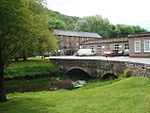Great Longstone for Ashford railway station
1863 establishments in England1967 disestablishments in EnglandDisused railway stations in DerbyshireEast Midlands railway station stubsFormer Midland Railway stations ... and 5 more
Grade II listed buildings in DerbyshirePages with no open date in Infobox stationRailway stations in Great Britain closed in 1967Railway stations in Great Britain opened in 1863Use British English from March 2015

Great Longstone for Ashford railway station was a station which served Great and Little Longstone in the Peak District of Derbyshire. It was opened in 1863 by the Midland Railway on its extension of the Manchester, Buxton, Matlock and Midlands Junction Railway from Rowsley.
Excerpt from the Wikipedia article Great Longstone for Ashford railway station (License: CC BY-SA 3.0, Authors, Images).Great Longstone for Ashford railway station
Monsal Trail, Derbyshire Dales
Geographical coordinates (GPS) Address Nearby Places Show on map
Geographical coordinates (GPS)
| Latitude | Longitude |
|---|---|
| N 53.2367 ° | E -1.7059 ° |
Address
Monsal Trail
DE45 1NY Derbyshire Dales
England, United Kingdom
Open on Google Maps









